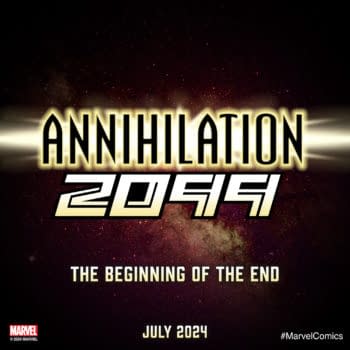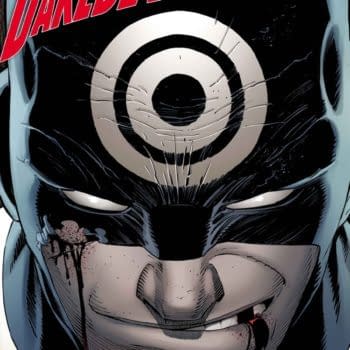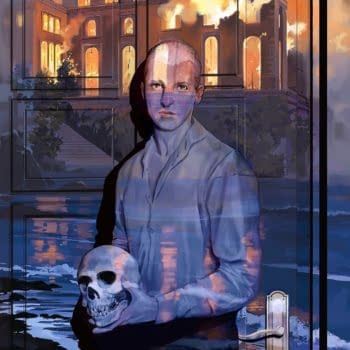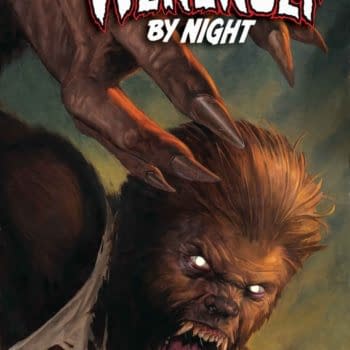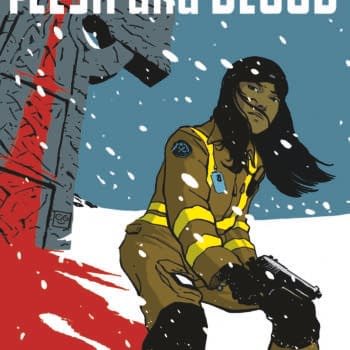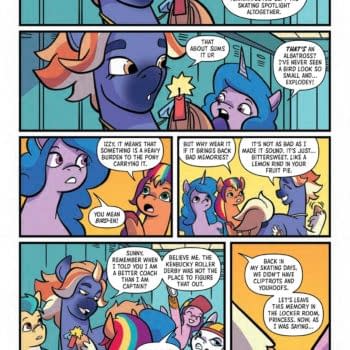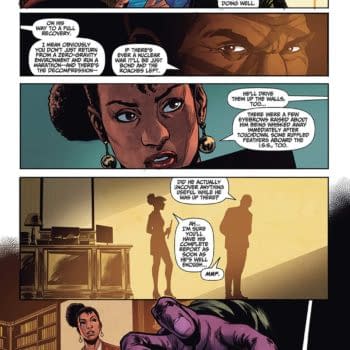Posted in: Comics | Tagged: Comics, entertainment
One Week In This Library And Comics May Never Be The Same – Talking With W. Maxwell Prince
W. Maxwell Prince has joining us today to talk about his upcoming book from Image Comics, One Week In The Library. This book is unlike anything I've encountered in comics so far, presenting several different approaches to visual storytelling in one volume. Though it draws on hints and clues within our comics tradition of the ways in which the medium can be shaped and changed, this book sets out with the intent of changing the shape and form of comics storytelling in each chapter to create a dynamic experience for the reader.
Consisting of seven chapters, set forth as a single day's duration each, and in some ways acting as standalone stories, One Week in the Library engages directly with literary tradition in a surreal fashion. Our central character, a librarian, attempts to keep the living literary works in his library in check, encountering often frightening, but always thought-provoking challenges. W. Maxwell Prince has taken on large swaths of shared cultural experience in his comics before, as seen in his previous graphic novel Judas, and current single-issue series at IDW, The Electric Sublime, which turns surrealism in art into a "crime adventure".
Prince's art collaborator on Judas, John Amor, has returned to work on One Week in the Library, joined by colorist Kathryn Layno. Letters on the book are by Good Old Neon and charts have been included as designed by Ashley Walker. Two creative powerhouses come together to present the book, with Frazer Irving creating the cover and Tom Mueller contributing design work.
W. Maxwell Prince has taken the time to answer quite a few questions for us about this experimental work.
Hannah Means-Shannon: Having come off a book with Biblical history and the worlds of heaven and hell as its backdrop, Judas, and currently publishing a surreal series about the art world, both at IDW, it seems like an interesting addition to the set to write a book about literary tradition. Has it been intentional for you to pursue such distinctive categories with each new project?
W. Maxwell Prince: I suppose in a way it has. My first rule for writing anything is to chase after what interests me. So the stuff I've covered in my comics (faith, art history, the power of a word) are just things that tend to turn me on and move my needle all the way to the right. I've been lucky that my sequential explorations stand apart from each other and make a corpus that seems "distinctive." (Which is to say: thanks!)
HMS: Having worked on a full-length graphic novel with John Amor before, Judas, do you have established ways of working together, or are you still changing things up?
WMP: John and I have a pretty standard script-to-thumbnail-to-illustration methodology for making a page of comics. But we've worked together for so long (going on 8 years!) that I think we've started to kind of reach into each other's heads to understand what needs to happen to make one of our pages really alive. Every time I sent him a new idea for a chapter of One Week in the Library, he seemed to immediately intuit what I was trying to do and the best way to make the work stand up.
HMS: To be "avant garde" or "experimental" is something folks tend to define differently. How would you describe it, or particularly in relation to the comics medium?
WMP: For me, it serves as a response maybe to some sort of dissatisfaction with what the mainstream has to offer. I wanted to break away from what a lot of us comic readers know as the prevailing structure of an issue: mini-reveals on each page turn, some big splash cliffhanger on the final page to bring you back to the shelves next month. I do that stuff in The Electric Sublime, and it works just fine. There's a reason certain things get codified.
But OWITL was my chance to ask, "What would a comic free from the constraints of serial publication look like?" Or maybe more specifically, "What would my offering be, given that kind of freedom?" I was exceedingly happy with the answer, and exceedingly lucky that Eric Stephenson saw merit in the outcome.
HMS: What are some works that made you aware of the ways in which the medium could be challenged? I think the first time I read prose meta-material, for instance, was in Watchmen. Are there books or comics that caught your attention?
WMP: For my money, The Sandman is far and away the best self-reflective work in comics. It's this protean thing that knocks you out with each new shape it takes on.
Another great one is Matt Madden's 99 Ways to Tell a Story. It's 99 one-page comics that all tell the exact same story, but in different modes and from different vantages. It's a pretty strong statement on the inherent power (and advantages) of a story told through panels.
Outside of comics: all Borges, all the time. Robert Coover, George Saunders, Denis Johnson. I could go on forever.
HMS: There's a kind of double-edged relationship between comics and literature, in my opinion. On the one hand, even Will Eisner wanted his graphic novels to be shelved next to prose novels to show their relationship, but on the other hand, if you try to create comics in the same way that literature is created, that leads to very turgid, static comics that are text-heavy. This book is decidedly "literary" in its characters and references, and yet the medium is always in the spotlight. Is this a way of bringing the best elements of literature and the best features of comics together?
WMP: Golly, that's a good question. For my part, I'll say that the worlds of traditional lit and traditional comics occupy equally potent, expansive spaces inside of me. Everything I make comes from those twin sensibilities, and is, if I'm editing myself well enough, a balanced composite of the two.
But you're right: a lot of the time, trying to marry these mediums results in this completely impregnable work that is neither pleasurable to read nor improving in the way that sophisticated writing is supposed to be. I think maybe Judas: The Last Days is actually an example of that unevenness—in that book, I kind of messed up, and the relationship between complexity/sophistication and writing that feels alive is thrown off. The end result is something that has no real urgency.
I think/hope that One Week in the Library addresses that misstep in some way; it's about as honest as I can make a book.
HMS: I'm not totally surprised that this book is being published by Image, but perhaps a little surprised. When I look at the way the book is constructed, I think of Top Shelf or Fantagraphics, perhaps Drawn & Quarterly, but when I look at Amor's art style, which is both indie and mainstream in its feel, that's more like the art styles you see from Image rather than the other publishers I've mentioned. However, it's also less common at Image to publish full-length single-volume anthologies, and this book is structured more like an anthology. Can you tell us more about this publishing choice and the options you faced as a creator in publishing this book?
WMP: The answer might be kind of boring, but the truth is that I had no real intention of these stories ever getting published. Much of the point of working on these was to specifically operate outside of this idea that hard work on a story or piece of art should/has to result in other people reading it. A journey not for the destination, and all that.
But I liked the first 3 stories enough to send them Eric Stephenson's way, and he was open to giving the whole project a home at Image. I think it's way different than anything Image is currently putting out, and hopefully people try the thing on those grounds.
HMS: This book conveys a great love of books and stories, but also presents anxiety as a theme—anxiety of too much information, too many stories to comprehend them all. Do you think we live in an age of too much information? It seems like there are actually so many stories out there, and some are really life-changingly good, but it can be hard to sort through them all to find the really astonishing ones.
WMP: Oh, absolutely. My primary daily anxiety is directly concerned with information—how much you can access, how much you can retain, how much you can convey to other people. For me it manifests most acutely on the level of language: I'm constantly worried about how I'm articulating myself to other people, and what my way of talking says about me to the listener. It's a huge locus of insecurity for me, and one that I try to confront head-on in the final chapter of OWITL.
But more to what you're asking, I think we all probably feel that flavor of info- and story-related dread. There are so many books to read, so many websites to check per day, so many good television shows to binge. And the truth is that no one person can possibly attack all of this stuff without losing their minds. (Or even worse, having no one thing stick around and sink its hooks in you long enough to make an impact.) The best we can probably do is to carve out some time to enjoy what the world has to offer, and to make informed choices about how you spend your precious minutes. There's no one right way to do it–which is sort of the thesis of this book, I guess.
HMS: Can you tell us about the premise and structure behind the library in this story, and how you conceive of it? Is it influenced by legendary or real libraries at all?
WMP: The gist is: The Library is a place where every story ever written (and every variation thereof) is housed and guarded by a single Librarian. OWITL is told, for good chunks, from the POV of the Librarian, who realizes that the books are sort of acting up—he winds up losing himself in all these stories as they come to life around him in different ways. Each "chapter" of the book is a day in the library (hence One Week…), and a different exploration of a type of storytelling. If you don't mind, I'm going to paste my crib sheet below, which I think might give a reader a better of idea of what the book is trying to do:
Thursday – intro to the library and the leaky books; an epistemological meditation
Friday – twist on Pinocchio/hero's tale
Saturday – features typeset prose; Goldilocks, but with antidepressants and a horny ghost
Sunday – features infographics/charts by Ashley Walker; the Librarian's lament
Monday – silent story; merges the worlds of the Ugly Duckling, Charlotte's Web, Babe, and some other stuff
Tuesday – plays with color; exploration into "other worlds" by way of Narnia, Wonderland, and the Matrix
Wednesday – culmination; features me (W. Maxwell Prince) as a character, with a little cameo by Grant Morrison.
The Library itself is a bastardization of Borges' Library of Babel, with a bit of LSD mixed in.
HMS: What is it about Amor's artwork that makes him the perfect collaborator for such a challenging book?
WMP: John is so good at fantastical imagery. Over the course of our relationship, the things I've asked him to draw have only gotten stranger and stranger, and his ability to delineate those things has risen commensurately with the strangeness. I don't know anyone that can execute bears-wearing-tutus quite as well. It's that ability to adapt that made him a no-brainer for a project of this scope.
HMS: Can you tell us a little bit about the other team members? Kathryn Layno seems to capture that storybook feeling as colorist that has a major impact on the tone of the series, for instance.
WMP: Kathryn is the perfect artist to color John's lines. She treated the first story, Thursday, with this kind of haunting purple-and-pink glass effect that wound up informing how I conceived the rest of the chapters.
And I should mention Ashley Walker! Ashley is a colleague of mine at Pop Chart Lab, where we make charts of…well, everything. Ashley helped bring the infographics in "Sunday" to life—her depiction of the various "galleries" of the Library is especially inspired.
HMS: Frazer Irving's cover is absolutely lovely—what sort of dialogue did you two have regarding the cover?
WMP: Isn't it? Frazer is so easy to work with. I didn't want to give him too much direction, lest I hamper his natural abilities. He read some chapters and just went to town on what I think is the perfect cover. Pretty much everything he sent my way was greeted with a "yes."
HMS: Can you tell us about Tom Muller's involvement? The cover seems to have a library card motif—is that Tom's work?
WMP: Yep, that's all Tom. He dreamed up the library insert motif. Which is maybe an obvious choice, but I think he executed it in an unobvious way. I don't need to sing his praises—just look at a comic stand to see what kind of influence he's having on the medium. Good design is here to stay, I hope.
One Week in the Library is a graphic novel currently listed in Previews with order code: SEP160780. It arrives in comic shops on December 7th. You can find out more about it here.


















